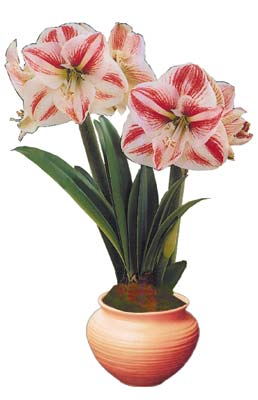I first became acquainted with this beautiful plant about 13 years ago when I was helping out in a second grade classroom at our local elementary school. Miss Schon, the teacher, brought in a bulb planted in a pot in February. During the next few weeks this bulb produced leaves which grew quite tall and had to be staked. What was most amazing were the blossoms that were produced by this plant. Four huge red blooms, which were about four inches across, opened at the top of the stalk. They lasted for a week or more and were a source of amazement to the students and to me. My next encounter with this plant was 6 years ago when my mother-in-law received one as a gift. I helped her care for the plant, which had beautiful salmon colored blossoms, and when she died in 1997 it became my plant. I have had it for several years now and have never known for sure how I was to care for this plant. It is still a source of amazement to me when it blooms even though my research indicates that I have not been doing all of the correct things to care for it. This indicates to me that this is a plant that will tolerate less than ideal conditions and still produce blossoms. This is my type of plant! The amaryllis was first discovered growing in the Andes Mountains of Chile and Peru by Eduard Frederich Poeppig, a young German physician, in 1828. It is named after a shepherdess in Greek mythology, and its botanical name is Hippeastrum. The plant foliage grows to a height of 24 to 36 inches and usually has 1 central flower stalk, which will produce 2-6 large colorful blooms. The blooms can range from a brilliant red to white or salmon or they may bicolored. Most amaryllis bulbs are produced in Holland, South Africa or Israel. The amaryllis is usually grown as a houseplant, but it can also be placed outdoors during the spring and summer when all danger of frost is past. It could be grown completely outdoors in southern climates where it does not freeze. Place it in the ground (pot and all) in a semi-shady place. It needs to have a well-drained soil, and the soil should never cover more than two thirds of the bulb. During this period, the foliage is restoring the bulb so that it can again blossom in another season. The plant should be removed from the flowerbed in September before it frosts. The foliage should be removed once it has yellowed and then cut back to within a couple of inches of the top of the bulb. It is now time for a nice rest in a cool place (45-50 degrees) for at least 8 weeks. During this time no water or fertilizer is applied to the resting bulb. Once this period has passed it is time for the truly
amazing part of growing this plant. It now needs to be removed from
storage and watered so that growth will begin. Once new growth is
visible the plant needs to be placed in a sunny southern exposure
where the temperature is about 70 degrees. It also requires regular
watering (do not overwater) and fertilization with a complete fertilizer.
In 6 to 8 week the plant should be ready to produce about 4 very large
and Sources: Amaryllis:Year-Round
Care |

 beautiful
blossoms. Some of the literature that I read indicated that some plants
may produce up to six blooms, but I have only had 4 blooms on my plant.
When the plant is in bloom it should be removed from the sunny exposure
so that the blooms will last longer. It also likes a cooler temperature
at this point. The blooms should be removed as they wilt so they do
not sap more energy from the bulb by trying to produce seeds. When
all blooming is finished the flower stalk should be cut down close
to the top of the bulb. One needs to continue watering and fertilizing
the foliage so that the bulb can rejuvenate itself. It can again be
moved outdoors to enjoy the summer when the time is right. I hope
with proper care my bulb will continue to enchant me for many more
growing seasons.
beautiful
blossoms. Some of the literature that I read indicated that some plants
may produce up to six blooms, but I have only had 4 blooms on my plant.
When the plant is in bloom it should be removed from the sunny exposure
so that the blooms will last longer. It also likes a cooler temperature
at this point. The blooms should be removed as they wilt so they do
not sap more energy from the bulb by trying to produce seeds. When
all blooming is finished the flower stalk should be cut down close
to the top of the bulb. One needs to continue watering and fertilizing
the foliage so that the bulb can rejuvenate itself. It can again be
moved outdoors to enjoy the summer when the time is right. I hope
with proper care my bulb will continue to enchant me for many more
growing seasons.